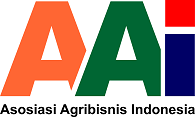The Contribution of Yam Farming Activities To Livelihood of Farmers In Ekiti State, Nigeria
Abstract
Keywords
Full Text:
PDFReferences
Adebo, G.M., and Ajiboye, A. (2014) "Comparative Analysis of Poverty Level among Rural and Urban Farmers in Ekiti and Ondo States". Developing Country Studies, 4 (20): 24-27.doi:https://doi.org/10.1.1.851.8389
Adesiji, G.B., Komolafe, S.E., Kayode, A.O., and Paul, A.B. (2016) "Socio-Economic Benefits of Oil Palm Value Chain Enterprises in Rural Areas of Kogi State Nigeria". Production Agriculture and Technology Journal (PAT), 12 (1); 36-47.
Adisa, R.S., Adefalu, L.L., Olatinwo, L.K., Balogun, K.S., and Ogunmadeko, O.O. (2015) "Determinants of post-harvest losses of yam among yam farmers in Ekiti State, Nigeria". Bull. Inst. Trop. Agr., Kyushu Univ., 38: 73-78.
Akangbe, J.A., Awotoye, O.A., Komolafe, S.E., and Ajibola, B.O. (2015) "The Contribution of Small Scale Poultry Farmers to Poverty Reduction in Oyun and Offa Local Government Areas of Kwara State, Nigeria". Tropical Agriculture (Trinidad) 92 (2): 162-171.
Awoniyi, O.A., and Omonona, B.T. (2006) "Production Efficiency in yam based enterprises in Ekiti State, Nigeria". Journal of Central European Agriculture, 7 (4): 627-636. https://doi.org/10.5513/jcea.v7i4.404
Barrett, C.B., Christiaensen, L. Sheahan, M. and Shimeles, A. (2017) "On the structural transformation of rural Africa". Journal of African Economies, 26 (AERC Supplement 1): i11-i35. https://doi.org/10.1093/jae/ejx009
Department for International Development of the United Kingdom DFID (1999). Approch to Sustainable Livelihood: www.nssd.net/references/SustLiveli/DFIDapproach.htm, accessed 4th April 2018.
Ellis, F. (2000) "The Determinants of Rural Livelihood Diversification in Developing Countries". Journal of Agricultural Economics, 51 (2): 289-302. https://doi.org/10.1111/j.1477-9552.2000.tb01229.x
Ekumade, A.B. and Osundare, F.O. (2014) "Determinants and Effect of Livelihood Diversification on Farm Households in Ekiti State, Nigeria". Journal of Economics and Sustainable Development, 5 (5): 104-110. https://www.iiste.org/Journals/index.php/JEDS/article/view/11562
FAO. (2012) "Entrepreneurship in farming: Farm management extension guide". Food and Agriculture Organisation of the United Nations Rome. https://doi.org/10.13140/2.1.3657.6325
Fawole, O.P., and Oladele, O.I. (2007) "Sustainable food crop production through multiple cropping pattern among farmers in South West Nigeria". Journal of Human Ecology, 21 (41): 245-249. https://doi.org/10.1080/09709274.2007.11905980
Gibb, A.A. (2000) "In pursuit of a new "˜enterprise' and "˜entrepreneurship' paradigm for learning: creative destruction, new values, new ways of doing things and new combinations of knowledge". International Journal of Management, 4 (3): 233-69.
Haggblade, S. (2011) "Modernizing African agribusiness: reflections for the future". Journal of Agribusiness in Developing and Emerging Economies, 1: 10-30.
Huttunen, S. (2019) "Revisiting agricultural modernisation: Interconnected farming practices driving rural development at the farm level". Journal of Rural Studies, 71: 36-45. https://doi.org/10.1016/j.jrurstud.2019.09.004
Izekor, O.B. and Olumese, M.I. (2010) "Determinants of Yam Production and Profitability in Edo Sate, Nigeria". African Journal of General Agriculture, 6 (4): 205-2010. http://www.asopah.org/journals/ajga/a...
Jibowo, G. (1992) "Essential of Rural Sociology". Gbemi Sodipo Press Ltd., Abeokuta, Nigeria. http://www.sciepub.com/reference/5817
Kabir, M.S., Hou, X., Akther, R., Wang, J. and Wang, L. (2012) "Impact of Small Entrepreneurship on Sustainable Livelihood Assets of Rural Poor Women in Bangladesh". International Journal of Economics and Finance, 4 (3): 265-280.
Khowa, T. and Mukasi, T.J., (2021) "Agro-processing as a tool for poverty alleviation strategy: A case of Raymond Mhlaba municipality". Africa's Public Service Delivery and Performance Review 9 (1): a463. https://doi.org/10.4102/apsdpr.v9i1.463
Komolafe, S.E. (2018) "Impact of yam entrepreneurial activities on livelihood of farmers in Ekiti State, Nigeria". PhD thesis in the Department of Agricultural Extension and Rural Development, University of Ilorin, Nigeria.
Mahmood, B., Mahmood, N., Sohail, M.M., and Saeed, S. (2016) "The Role of Entrepreneurship in Sustainable Livelihood Strategies of Old Aged People; Evidence from Sargodha, Pakistan". British Journal of Economics, Management & Trade, 14(2): 1-16.
Naminse, E.Y., and Zhuang, J. (2018) "Does farmer entrepreneurship alleviate rural poverty in China? Evidence from Guangxi Province". PLoS ONE 13 (3): e0194912. https://doi.org/10.1371/journal.pone.0194912
Naminse, E.Y., Zhuang, J., and Zhu, F. (2019) "The relation between entrepreneurship and rural poverty alleviation in China". Management Decision, 57 (9): pp. 2593-2611. https://doi.org/10.1108/MD-11-2017-1153
National Bureau of Statistics [NBS] (2012). "Nigeria poverty profile". Nigerian Bureau of Statistics, Abuja, Nigeria. January, 2012
Nnadi, F.N., Chikaire, J., Echetama, J.A., Ihenacho, R.A. and Utazi, C.O. (2013) "Assessment of agricultural extension strategies for poverty alleviation in Imo State, Nigeria". Net Journal of Agricultural Science, 1 (2): 17-23.
Oluwasusi, J.O., and Tijani, S.A. (2013) "Farmers' adaptation strategies to the effect of climate variation on yam production: a case study in Ekiti State, Nigeria". Agrosearch, 13 (2): 20-31. http://dx.doi.org/10.4314/agrosh.v13i2.3
Pawlak, K. and Kołodziejczak, M. (2020) "The role of agriculture in ensuring food security in developing countries: Considerations in the context of the problem of sustainable food production". Sustainability, 12(13), a5488.
Tang, Q., Bennett, S.J., Xu, Y., and Li, Y. (2013) "Agricultural practices and sustainable livelihoods: Rural transformation within the Loess Plateau, China". Applied Geography, 41:15-23. http://dx.doi.org/10.1016/j.apgeog.2013.03.007
Uche, C., and Familusi, L. (2018) "The adoption of agripreneurship as a mitigating measure to unemployment in Nigeria: a topical review". Global Journal of Management and Business Research, 18 (2): 25-31.
Udoh, E.J., Akpan, S.B., and Uko, E.F. (2017) "Assessment of Sustainable Livelihood Assets of Farming Households in Akwa Ibom State, Nigeria". Journal of Sustainable Development, 10 (4): 83-96.
Vik, J., and McElwee, G. (2011) "Diversification and the entrepreneurial motivations of farmers in Norway". Journal of Small Business Management, 49 (3): 390-410 https://doi.org/10.1111/j.1540-627X.2011.00327.x.
Yanya, M., Abdul-Hakim, R., and Abdul-Razak, N.A. (2013) "Does entrepreneurship bring an equal society and alleviate poverty? Evidence from Thailand". Procedia Soc Behav Sci., 91: 331-340.
Zhifei, L., Qianru, C., and Hualin, X. (2018) "Influence of the Farmer's Livelihood Assets on Livelihood Strategies in the Western Mountainous Area, China". Sustainability MDPI, 10:875. https://doi.org/10.3390/su10030875
DOI: https://doi.org/10.37046/jaj.v4i1.13706
Refbacks
- There are currently no refbacks.
Copyright (c) 2022 Author

This work is licensed under a Creative Commons Attribution-NonCommercial-ShareAlike 4.0 International License.
Jambura Agribusiness Journal (P-ISSN: 2685-5860, E-ISSN: 2685-5771) is licensed under a Creative Commons Attribution-NonCommercial-ShareAlike 4.0 International License. Powered by Public Knowledge Project OJS










